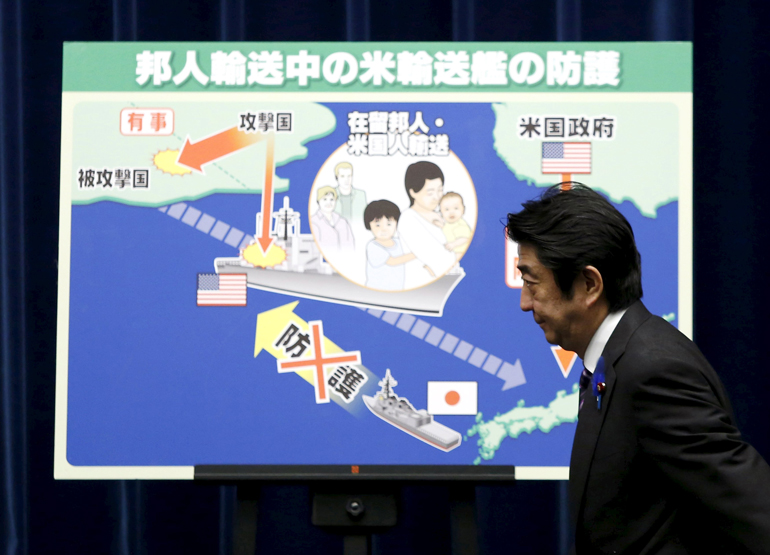Saturday Dec 06, 2025
Saturday Dec 06, 2025
Saturday, 25 July 2015 00:00 - - {{hitsCtrl.values.hits}}
 Japan’s Prime Minister Shinzo Abe arrives at a news conference in front of a placard showing a defensive scenario for the protection of Japanese nationals overseas, at his official residence in Tokyo in this July 1, 2014 file photo. Japanese Prime Minister Shinzo Abe is using ‘anime’ cartoons, Internet chats and even an unusual show-and-tell TV appearance, complete with a mockup of burning buildings, in an effort to persuade wary voters that his bolder defence policy makes sense. So far, it isn’t working. REUTERS
Japan’s Prime Minister Shinzo Abe arrives at a news conference in front of a placard showing a defensive scenario for the protection of Japanese nationals overseas, at his official residence in Tokyo in this July 1, 2014 file photo. Japanese Prime Minister Shinzo Abe is using ‘anime’ cartoons, Internet chats and even an unusual show-and-tell TV appearance, complete with a mockup of burning buildings, in an effort to persuade wary voters that his bolder defence policy makes sense. So far, it isn’t working. REUTERS
Reuters: Japanese Prime Minister Shinzo Abe is using ‘anime’ cartoons, internet chats and even an unusual show-and-tell TV appearance, complete with a mock-up of burning buildings, in an effort to persuade wary voters that his bolder defence policy makes sense.
So far, it isn’t working.
Abe’s popularity rating, once as high as 60%, has slumped as he makes changes to Japan’s post-war security stance, such as legislation enabling its armed forces to defend a friendly nation under attack. His disapproval rating topped 50% after the bills passed the lower house last week.
Abe had a far easier sales job when he won power in December 2012, vowing to reboot the economy. Now he faces protests and a majority of voters who do not understand his security policy or feel it is dangerous and violates Japan’s pacifist constitution.
Some think Abe is losing his cool. “The ratings are tough,” said a source from the ruling Liberal Democratic Party (LDP). “I think they (Abe’s inner circle) are getting flustered.”
This month, the LDP released an ‘anime’ entitled “Tell me, moustachioed commander!”, in which a character modelled after LDP lawmaker and former army commander Masahisa Sato chats to a high-school girl, Akari, while commuting on a train, assuring her the changes are needed but won’t increase the risk of war.
“Do you know there are countries pointing missiles at Japan?” the Sato character asks. “What will we do if they are fired?”
Akari replies: “Eh? They’ll fire them? No, No! Someone protect us!”
The cartoon also includes an image, echoing one Abe introduced at a news conference last year, of a Japanese mum and child being rescued by a US ship that comes under attack.
The ‘anime’ inspired a parody, in which Akari fires back that the legislation is unconstitutional and that the government is acting dictatorially, and asks why it is pussy-footing around by not specifically naming arch-rival China as the threat.
Abe has also taken to the Internet. In one episode on a LDP Web channel, he likens collective self-defence to an incident in which ‘buddy Aso’ (Finance Minister Taro Aso) volunteers to protect Abe from bullies – and gets punched himself.
The new laws, Abe said, would allow him to defend Aso.
Opposition lawmakers accused Abe of talking down to voters.
On Monday, Abe appeared on national TV with a model of an American house spewing fake smoke and fire. The mock flames spread to a smaller US building and threaten to engulf a Japanese house. At that point, Abe said, demonstrating with cut-outs, Japanese ‘fire fighters’ help to douse the fire.
The show-and-tell reaped online ridicule.
Abe, who says the changes are vital to cope with growing threats in the region, has vowed to press on. “We are not doing politics to win support but rather, while obtaining support, we want to do what needs to be done,” he said on Monday’s TV show.
Debate in the upper house will likely start next week. If no vote takes place within 60 days, the ruling bloc can then enact them with its two-thirds majority in the lower house, a step it would prefer to avoid for fear of looking high-handed.
For now, nearly all of Abe’s critics in the LDP are staying mum, reassured by the opposition’s even soggier support rates.
“There is dissatisfaction, but people are silent,” the LDP source said. That could change, experts say, if Abe’s ratings fall further, possibly encouraging a rival in a September LDP leadership race as the party eyes an upper house poll next year.